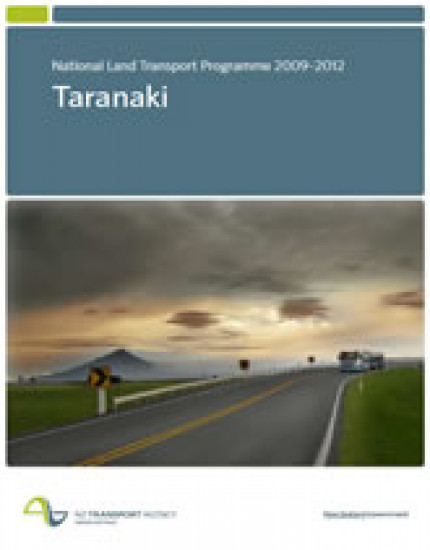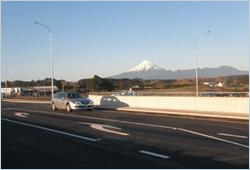There has been considerable investment and improvement in the Taranaki transport network in recent years – largely in response to New Plymouth’s residential and industrial growth and an increasing dependence on roading infrastructure by commercial transport, tourism and a growing local population. Safety has been a particular priority in this investment.


I'm pleased to introduce to you this National Land Transport Programme (NLTP) for 2009-2012 – the mechanism through which the NZ Transport Agency (NZTA) 'gives effect' to the Government policy statement on land transport funding 2009/10 – 2018/19 (GPS)(external link).
The global economic situation has changed dramatically in the past 18 months, with significant effects for the New Zealand economy. In response, and as part of its commitment to improving New Zealand's economic outlook and performance, the government has set clear expectations and priorities for the land transport sector. These expectations are articulated in the GPS.
The GPS is the government's statement of its short- to medium-term goals for transport investment. Issued in May 2009 and covering the 10 years between 2009 and 2019, it has a clear message: the number one priority for investment in land transport is increasing economic growth and productivity in New Zealand.
In particular, this means directing investment into high-quality infrastructure projects and transport services that encourage the efficient movement of people and freight and contribute to economic activity and employment. It's to be achieved by investing in the transport network, extracting better value for money from all land transport activities and enhancing individual projects' economic efficiency. Improvement of key routes also assists in delivering route security, network efficiency and provides safety benefits.
The NZTA's role is to allocate money from the National Land Transport Fund to activities within activity classes in the GPS. Through our rigorous assessment and prioritisation process, we aim to draw a balance between national and regional priorities (identified in the regional land transport programme (RLTP)), and between networks' local and regional, and inter-regional and national roles. We're also committed to delivering value for money in all transport activities, in all regions.
A strong commitment to value for money has also led to changes in how R (regionally distributed) funding is used. R funds come from fuel excise duty and light road user charges and are allocated proportionally to regions based on population. In the past, R funding was used to fund lowerpriority projects that would otherwise not qualify for funding.

To ensure value for money, R funding will be used for the highest-priority projects in this NLTP, providing a guaranteed minimum level of funding for the Taranaki region.
The National Land Transport Fund can only be used to fund activities listed in the NLTP. The tables in this NLTP list:
This document details the funding provided for the Taranaki region – and as a dynamic document will be reviewed and updated regularly to reflect any approved variations to programmes. For information on funding for the rest of New Zealand (and how the NLTP is developed and managed) please see the national NLTP document.
There has been considerable investment and improvement in the Taranaki transport network in recent years – largely in response to New Plymouth's residential and industrial growth and an increasing dependence on roading infrastructure by commercial transport, tourism and a growing local population. Safety has been a particular priority in this investment.
Given Taranaki's challenging topography and an industry heavily dependent on agriculture and petrochemicals, investment for the next three years is driven by two key priorities: route security and safety. It reflects how we see the NLTP delivering the best value to the Taranaki region: getting people and freight to their destinations, and getting them there safely by:
All regional activities included in this NLTP were drawn from the Taranaki RLTP. However, RLTPs throughout New Zealand proposed greater levels of activity than could be supported by the funding available. As a result, this NLTP includes activities that the NZTA anticipates funding because their indicative priority is sufficient to warrant it.
This NLTP provides an investment of $139.6 million for the Taranaki region over the 2009–2012 period. Paramount to supporting local and national economic activity is the need to maintain and improve route security, efficiency and safety. A number of activities, both current and planned, will target these priorities in the next three years.
For example, this NLTP will enable construction to start on the State Highway (SH) 3 Normanby overbridge and realignment, with property purchase and design to start in 2009/10. This project, identified as a high priority for the Taranaki Regional Transport Committee (RTC), will enhance safety on this important section of the state highway, which is a freight lifeline for the Taranaki region.
Another priority for the Taranaki RTC is the Midhurst rail overbridge replacement and realignment project, which is proposed for investigation, design and property purchase in this NLTP.
We're particularly encouraged by construction progress on the SH3 Bell Block bypass, which is due for completion in 2010, and the Rugby Road underpass, which is also approaching completion. The Bell Block bypass, located on the route to the north of New Plymouth, bypasses the existing highway and will help to reduce congestion and improve safety, while the Rugby Road underpass at Tariki will provide a safer and more reliable route, particularly for heavy vehicles.
Maintenance and operations activities make up a large proportion of the forecast expenditure in the Taranaki region. In addition to preserving the highway network and undertaking maintenance and improvements to meet future service levels, this will enable the NZTA to improve the availability of road condition information at critical locations on our state highway.
The NZTA has also identified a number of activities to improve the safety and efficiency of sections of SH3 for progress in the next five years, including road realignments and intersection improvements. Further work on managing or removing roadside hazards will also continue to offer financial and safety benefits. Meanwhile, we'll maintain our on road engineering solutions that make roads more uniform and create safer travelling experiences and a more forgiving environment.
Route security on SH3, particularly north of New Plymouth, remains a priority, with ongoing maintenance and minor improvements work designed to ensure its future reliability, security and safety.
Recognising that limited passing opportunities on some parts of the region's road network can lead to driver frustration and crashes, we've identified a package of passing lanes throughout the region.
In other activities, funding for passenger transport services across the region will ensure that all existing bus and total mobility services continue. And NLTP-funded demand management and community programmes1 will enable councils to deliver local transport safety and sustainability activities throughout the region. Integrated planning will also come under the spotlight with the review of the Taranaki Regional Land Transport Strategy during 2009-2012.
For an overview of all projects in the region likely to receive funding in the next three years, see the regional map.
The Taranaki RTC has a pivotal role in shaping the Taranaki region's transport future through the Regional Land Transport Strategy and the RLTP.
The committee comprises elected members from the district authorities and Taranaki Regional Council, the NZTA, and community representatives with expertise in areas such as access and mobility, safety and personal security and economic development.
One of the committee's key tasks is to develop Taranaki's three-year RLTP, which prioritises all the regional transport activities proposed by the NZTA, local authorities and Taranaki Regional Council.
This regional perspective enabled the NZTA to build a geographic view of land transport requirements nationwide, and to align regional and national views in deciding on the most appropriate allocations of funds to give effect to the GPS priorities. Public submissions on Taranaki's draft programme were reflected in the final programme that went to the NZTA Board, which made the ultimate funding decisions for the NLTP.
I believe this NLTP will support Taranaki's social and economic wellbeing well into the future and assist its significant contribution to the national economy. I look forward to working closely with our regional partners and the Taranaki community to ensure it is implemented successfully.
Jenny Chetwynd
Regional Director, Central
Last updated: 6 October 2009